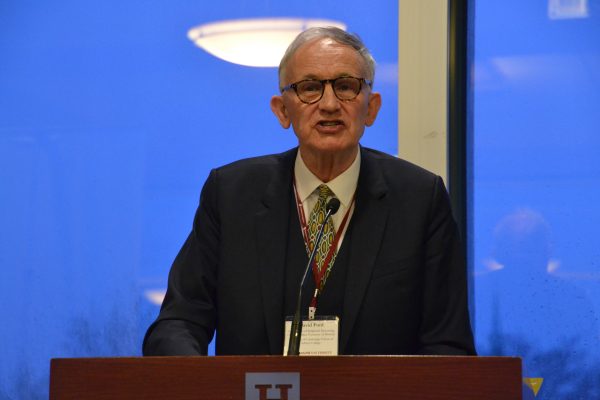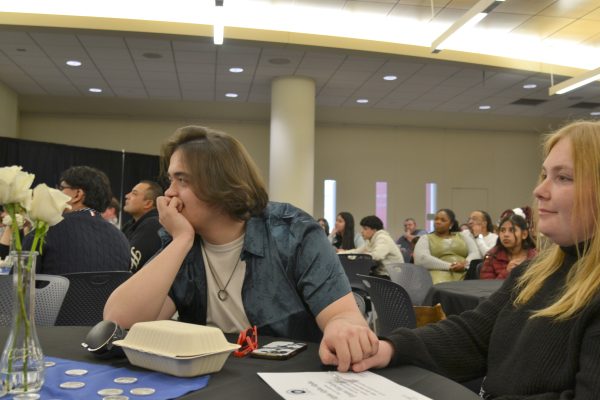Minnesota adjuncts draw national attention
Hamline adjuncts and administrator open up about unionization.
A document called “The Just In Time Professor” was released to congress by the House Committee on Education and the Workforce Democratic Staff in January. The opening paragraph reads, “The post-secondary academic workforce has undergone a remarkable change over the last several decades. The tenure-track college professor with a stable salary, firmly grounded in the middle or upper-middle class, is becoming rare. Taking her place is the contingent faculty: non-tenure-track teachers, such as part-time adjuncts or graduate instructors, with no job security from one semester to the next, working at a piece rate with few or no benefits across multiple workplaces, and far too often struggling to make ends meet. In 1970, adjuncts made up 20 percent of all higher education faculty. Today, they represent half.”
This report has created steam for focused commentary and demonstrations around the country. The Atlantic reported, “Over spring break, [Mary-Faith] Cerasoli publicly protested her working conditions on the steps of New York Department of Education wearing a vest emblazoned with the words ‘Homeless Prof’ on it.” National debate continues.
ON THE HOME FRONT
Last week’s demonstration at Macalaster College benchmarked the adjunct professors of Macalaster and Hamline petitioning to hold a union vote. Part of that petition’s organizing unit at Hamline are contingent faculty members Jennifer Beckham, Swati Avasthi and Juliet Patterson. “We are trying to bring this question to the larger body. Do we want a union or not?” said Patterson.
Juliet Patterson has been an adjunct at Hamline for eight years. She explained that the contingent faculty at Hamline is not a homogenous group. Every adjunct has different reasons why he or she is an adjunct. “Most of us are in it because we care about higher education and our students,” Patterson said.
Jennifer Beckham has been at Hamline nine years. This year she taught 80 first-year students whom she met with individually for conferences in addition to her normal responsibilities. “I work very hard to serve all my students, but that’s a lot of extra time outside the classroom.”
“You’ll hear an argument that full-time professors have a lot more responsibility in terms of their students and so forth and to some degree that is true, but most adjuncts are expected to be open to their students in the same way that a full-time teacher is. So I don’t have to tell you that a lot of the time of a full-time teacher is not just being in the classroom. It goes way beyond that,” said Patterson.
Patterson noted that the trend over the past ten years in academic institutions used increasing numbers of adjunct teachers—20 percent in 1970 to 51 percent today. “That picture is important,” said Patterson. “If more than half of faculty is adjuncting then I feel that body needs a voice at the table with the other faculty in terms of what’s happening at this institution.”
If more than half of faculty is adjuncting then I feel that body needs a voice at the table with the other faculty in terms of what’s happening at this institution.
— Juliet Patterson - adjunct professor
Patterson mentioned how the increasing numbers of contingent faculty being hired points to a picture of higher education changing and needing to change. Some blame the increasing role of contingent faculty—up 30 percent in 34 years—on economic strain and other factors. Patterson feels that economic strain and those other factors are reasons to re-evaluate how the system works, whether or not the current system is more beneficial to the education of the students it is supposed to serve, or the institution as a business model. She thinks there is a real need for change, and there wouldn’t be a national movement toward adjuncts organizing if this wasn’t the case. “We’re recognizing that our role is increasing,” Patterson said. “It appears academic institutions can’t function without contingent faculty. There’s tenure people and adjuncts. It’s a caste system. There are other ways of going about this. Systematically, this system is broken and it needs repair. I think we’re seeing this tenure structure coming to a head.”
It isn’t about wanting a full time job or trying to gauge the university, Patterson explained about the petition to unionize. “But I’d be hard pressed to find another job where you sign on to work part time and you’re not offered a cost of living raise if you’d been working/employed for eight years and shown good service,” said Patterson.
“Our pay is horrible,” Beckham said.
Avasthi wrote in an email interview, “While tuition keeps going up for students, salaries don’t. Hamline University is a tax-exempt institution whose mission is, fundamentally, to educate students excellently. If learning is the number one priority, then Hamline should put their money where their mission is. Getting and retaining the best teachers, whether adjunct or tenured, should be the priority.”
According to Beckham and Patterson, adjuncts don’t have a system of review at Hamline; they’re not monitored in any way. “Neither are we offered opportunities for professional development,” Patterson said.
WHY UNIONIZE?
Beckham thinks unionization of adjuncts will be good for Hamline. She doesn’t think that current situation is stable. “Adjuncts are valuated purely on student evaluations,” Beckham said. “There’s nothing formal.” She elaborated on how it’s not really a healthy system; a third of the classes are taught by people who come and go. “This is bad for the professors and there’s no continuity for the students,” said Beckham.
Some adjuncts may hang around institutions for a long time, despite the poor work conditions, because they are chasing contract or tenure-track jobs. “I only have anecdotal evidence, but between the lines it has been suggested that if you hang in here you’ll be rewarded with a part-time, secure position,” said Patterson. “But it hasn’t come to fruition.”
“There’s no recognition by the administration of your value,” Beckham said.
Adding to the rough conditions is the fact that contingent faculty are not contracted, sometimes, to teach for a semester until months in advance of the class, sometimes weeks. “That varies from department to department,” Patterson said. Some faculty may know, informally, that they are going to be teaching, but they also know that at any moment the bottom could drop out because they are not contracted. “Right now I live six months to six months to six months and I’ve been doing that for two years,” said Patterson.
Patterson had only been adjuncting “full-time” for the past two years. “I knew it was going to be somewhat difficult. I thought I’d take it transitionally to see how it would be. But now that I’m working in the trenches, the problems are more potent,” said Patterson.
The ways that academic institutions appear to prioritize their budgetary expenses is frustrating to these adjuncts. “I think that these are institutions that need to re-prioritize their dollars, which means doing some changing. Change is always scary, but often fruitful. Institutions of higher learning are supposed to be places where we discuss equity—something universities should model,” wrote Avasthi.
Beckham noted that despite having multiple qualifications she makes only a dollar or two above minimum wage. “And our benefit is library privileges,” said Beckham.
If learning is the number one priority, then Hamline should put their money where their mission is. Getting and retaining the best teachers, whether adjunct or tenured, should be the priority.
— Swati Avasthi - adjunct professor
Beckham said that the stereotype of a union invokes images of strikes and battles and that’s not the contingent faculty’s plan. “We’d like to form a bargaining unit and we’d like to negotiate our contracts,” Beckham said. “I’ve asked for raises before and been told that neither I, nor any adjunct, would receive one as long as there’s parity.”
Patterson noted that at Hamline the tuition has increased every year for the last ten years. She wants to know where that money is going. “I’m not here to gauge the administration or to say that I deserve as much as the full-time faculty, but I am saying that there’s something really wrong when the administrations focus is going to facilities and of other areas and they’re not paying attention to who’s on the ground and providing the education. How can the fee go up when contingent faculty is more than half [of all faculty] and they’re not receiving cost of living wages?”
She doesn’t see how the current system of “liberal arts education” is putting students at the center.
Hamline didn’t have the tenure system until very recently, Patterson explained. There were full time, part time and adjunct faculty. But now Hamline has adopted the tenure system and those tenure price tags suck up a lot more resources.
Adjuncts are paid a flat rate. “And it hasn’t changed in ten years,” Patterson said, “which isn’t equitable. And I think what we’re interested in is a more equitable relationship for the work that we do. I don’t think that’s an unreasonable request. So, why a union: because we’re a non-homogenous group, because we’re all advocating individually. If we have a collective voice I feel we’ll have a lot more power in terms of bargaining,” said Patterson. She has, until very recently, felt isolated as an adjunct and suggests that such diaspora may be intentional.
“While I’m a professor at a university I love, getting to teach students I respect, I will struggle to provide tuition for my own children because of how underpaid I am as an adjunct. That’s not a sacrifice I hoped to make when I value education so much, when I got my advanced degree and as I put so much into my teaching and scholarship everyday,” said Avasthi.
THE EFFECT IN THE CLASSROOM
“Most adjuncts have said they don’t want the cost to fall back on students and that’s one of our primary concerns,” said Patterson.
Patterson and Beckham argue that unionizing will actually protect students, student costs and faculty. Many adjuncts don’t have offices and may run between multiple institutions. Because they are in this situation—multiple jobs at multiple schools—they may cut corners because they’re trying to juggle too many things. And such unionization will protect contracted full-time and tenure-track professor as well. The more adjuncts there are to exploit, and the easier it is to exploit them, Patterson and Beckham argue, the more unnecessary tenure-track professors become.
“If you’re holistically helped by your employer, you may do a better job,” said Beckham.
It’s not just about money, Patterson agreed, but also being supported in a holistic way. She believes that this is exactly the kind of conversation adjunct representatives should have with institutions once they get representation. “We want to have the privilege to make changes,” said Patterson.
AN ADMINISTRATIVE PERSPECTIVE
Mike Reynolds used to be an adjunct and is now the Associate Provost at Hamline. He spoke on the subject of contingent faculty in a Star Tribune article in March. About doing that article he said, “I was very anxious. It’s hard to capture the nuance of a particular institution. I was willing to be the [national] representative voice. I was willing to take that on.”
Reynolds said that the article’s focus wasn’t just about Hamline but also looked at the national picture. “The Star Trib. asked if it was about money and I said, ‘yeah.’ How can you not say it’s about money?”
He explained that some of the places where Hamline uses contingent faculty are varied. “If I go on sabbatical for a year, rather than replacing you with a full-time person, we might bring in an adjunct. So you fill in around those sorts of things,” said Reynolds. He mentioned that one of the ways Hamline—a private institution—differs from a big research facility is that there’s a lot less interest in having adjuncts fill in at the beginning levels.
Reynolds said that when Hamline thinks about hiring and bringing in part time faculty, they don’t put an adjunct in a first year class. They try to use full-time faculty for lower level undergraduate classes. “We’ve been trying to be instrumental in undergrad and say, our students need guidance, a lot of things happen outside and beyond class so you want to have that full-time faculty, or faculty that have a long time standing within the institution, because they can guide students and be good advisors formally or informally,” said Reynolds. He says that Hamline tries to start new adjunct faculty at the 3000-level where the students are already acclimated to the college. “And these newer faculty will hopefully be able to enhance their academic experiences,” said Reynolds.
In fields like fine arts or business, Reynolds said, Hamline brings in a lot of practitioners—someone who does that job for a living—who are interested in teaching part-time. “We have practitioner adjuncts that have a long term relationship with us,” said Reynolds. For instance, the university may hire a gunfire expert to teach a forensics sciences class or an actual poet to teach poetry. “Practitioners represent a significant amount of adjuncts,” said Reynolds.
Reynolds doesn’t believe that the 50/50 ratio of full-time professors to contingent faculty captures the number of hours in the classroom. “We may have a hundred full-time faculty but they may be doing 4/5 or 5/6 of the teaching. We may have an equal number of faculty but how they are participating with students in the classroom may be different,” said Reynolds.
“It’s a difficult situation to bring in people who are going to work part time who want something more. And you don’t have something more,” said Reynolds. He noted the ongoing push-and-pull where the institution is trying to have more full-time people and more tenure track people and economizes that in different ways. Part-time faculty fills needs economically but are also practitioners, or stop gap for short-time needs or problems.
Reynolds noted the need to be equitable. “I think Hamline’s pay scale is not max, but it’s better than many. We pay attention to what is the general pay around the [Twin] Cities and are we in line or competitive. We try to do things like offer professional opportunities,” said Reynolds.
Not often mentioned in this discussion is the vicious cycle of the Graduate and Ph.D. students coming out of universities with the intent to teach. They need teaching experience and adjuncting is a great way for them to build their resumes. “It’s one of the reasons I taught as an adjunct as a graduate student,” said Reynolds. “So, we’re trying to be responsible, and not just to our students, but to the people we employ. Could we do better? Yeah. In my time working in the deans’ office there are a lot of ways we have done better and there are more ways that we could improve.”
Reynolds admitted that a lot of graduate programs take people’s money and then those students walk out with a big debt and a Ph.D. and no guarantee that they’re going to get a job. “And that’s not right,” said Reynolds. “For many, like my field—English—you get a Ph.D. and think, I’m going to teach, but there aren’t a lot of teaching jobs. I said in the [Star Tribune] article, ‘I think graduate schools are creating a surplus of trained professionals that want to be in their field,’ and I’ll say this cautiously, but institutions around the country are recognizing, ‘Hey, look at all these people with qualifications who we can employ who really want to work.’ It’s not a good situation and we keep reproducing the situation where we can keep it alive,” said Reynolds.
Reynolds said the unionizing pressure, and national attention to the plight of contingent faculty, is useful. “Whether it’s from a unionized adjunct pool or just from adjuncts trying to collectively define what their priorities are or what they’re looking for; it’s good for the institution to be thinking about what’s the right path and how to do it in a way that doesn’t break the bank, but is more in line with our mission. I’m all for that and how we get there,” said Reynolds.
“‘Do we depend on these institutions?’ I depend on these institutions in the same ways that everybody in this nation depends on these institutions. I care about them deeply. I think they’re incredibly important. I care about the students, but these institutions depend on adjunct instructors as well. I would say, to be fair, Hamline is not worse than most other institutions, but Hamline depends on adjunct instructors. I’m easily replaced so they don’t depend specifically on me, but they do depend on this work population. I also don’t depend on it because I’d be hard pressed to find something that doesn’t pay better,” said Beckham.
Speaking on the difficulty of this job market, Reynolds said, “When I went to graduate school I was mindful of the job market, that it was terrible. So, I didn’t go in thinking I would teach at Duke or Berkley. I thought I’d be happy at any teaching institution, including a community college. I liked teaching. So that gave me a lot more room. If it had come to it, I would have found something else to do.”
“I expect we will see a lot more of this [attention to the plight of adjuncts] nationally. As a nation, we need solutions for students with over-sized loans and for adjuncts with under-sized salaries. It’s all about where the university chooses to spend its tax-exempt dollars,” said Avasthi.
When asking the President of Hamline’s chapter of the American Association of University Professors (AAUP) to comment the response was as follows, “I hire and supervise adjuncts, so anything I say might be colored by that perspective. Second, since I’m currently president of the Hamline chapter of the AAUP, anything I said might be taken as ‘official’ statement by the AAUP. The AAUP chapter has recently adopted a statement on contingent hiring, which will appear as an ad in The Oracle.”





